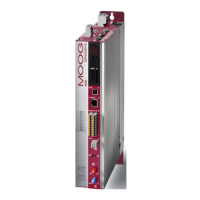MSDServoDrive AC-AC Operation Manual
moog
40
Id. no.:CA65642-001 Date:03/2012
to the glossaryto the table of contents
3.15.2 Design with integrated braking resistor Size1 - Size 4
The catalog only specifies the peak braking power for the servo drive with integrated
braking resistor (design G392-xxx-xxx-xx2 and G395-xxx-xxx-xx2, only available up to
and including Size4). The permissible permanent braking power must be calculated. It
depends on the effective loading of the controller in the corresponding application.
ATTENTION! No additional external braking resistor must be connected to
the servo drive G392-008 to G392-032/G394-032 with integrated braking
resistor.
In general the servo drive is thermally designed in such a way, that no energy input by
the internal braking resistor is permitted during continuous operation with rated AC
current and under maximum ambient temperature. Thus the controller design with
integrated braking resistor only makes sense, if the effective servo drive load is ≤80%,
or the braking resistor has been planned for one-time emergency stopping. In case of
an emergency stop the heat capacity of the braking resistance can only be utilized for a
single braking operation. The permissible energy W
IBr
can be taken from the following
table.
Device Technology
Rated
resistance R
BR
Peak braking
power P
PBr
Pulse
energy W
IBr
K1
G392-004A
PTC
90Ω
1690W
1)
600Ws
95W
G392-004
G392-006
1690W
2)
95W
G392-008
G392- 012
Wire resistance
4700W
3)
6170W
4)
6500W
5)
6000Ws
230W
G392-016/
G395-016
G392-020/
G395-020
360W
G392-024/
G395-024
G392-032/
G395-032
480W
1) Data referred to 1x230V mains voltage (BR switch-on threshold 390V
DC
)
2) Data referred to 3x230V mains voltage (BR switch-on threshold 390V
DC
)
3) Data referred to 3x400V mains voltage (BR switch-on threshold 650V
DC
)
4) Data referred to 3x460V mains voltage (BR switch-on threshold 745V
DC
)
5) Data referred to 3x480V mains voltage (BR switch-on threshold 765V
DC
)
Table 3.21 Data of the integrated braking resistor
(design G392-xxx-xxx-xx2 and G395-xxx-xxx-xx2)
!
If the drive is not permanently operated at its power limit, the reduced power dissipation
of the drive can be used as braking power.
NOTE: Further calculation assumes that the servo drive is used at maximum
permissible ambient temperature. This means that any additional energy input
from the internal braking resistor caused by low ambient temperature will be
neglected.
To calculate the continuous braking power please proceed as follows:
• Calculation of the effective utilization of
the servo drive during a cycle T:
dti
T
I
T
eff
∫
=
0
2
1
Br
T
PBrDBr
dtP
T
P
∫
×≥
0
1
11K
I
I
P
N
eff
DBr
×−=
∫
×=
T
Br
DBr
PBr
dt
P
P
T
0
T
P
P
T
DBr
PBr
BrSum
×=
• Determination of the permissible continu-
ous braking power on basis of unused
drive power:
dti
T
I
T
eff
∫
=
0
2
1
Br
T
PBrDBr
dtP
T
P
∫
×≥
0
1
1
I
I
P
N
eff
DBr
×−=
∫
×=
T
Br
DBr
PBr
dt
P
P
T
0
T
P
P
T
DBr
PBr
BrSum
×=
Boundary conditions
• A single braking process must not exceed
the maximum pulse energy of the braking
resistor.
W
IBr
≥ P
PBr
xT
Br
• The continuous braking power calculated
for the device must be greater than the ef-
fective braking power of a device cycle.
Br
T
PBrDBr
dtP
T
P
∫
×≥
0
1
11K
I
I
P
N
eff
DBr
×−=
∫
×=
T
Br
DBr
PBr
dt
P
P
T
0
T
P
P
T
DBr
PBr
BrSum
×=
This results in the minimum permissible
cycle time T with calculated continuous
braking power:
dti
T
I
T
eff
∫
=
0
2
1
Br
T
PBrDBr
dtP
T
P
∫
×≥
0
1
11K
I
I
P
N
eff
DBr
×−=
∫
×=
T
Br
DBr
PBr
dt
P
P
T
0
The maximum total switch-on time of
the braking resistor over a specified cycle
time T with calculated continuous braking
power results from:
dti
T
I
T
eff
∫
=
0
2
1
Br
T
PBrDBr
dtP
T
P
∫
×≥
0
1
11K
I
I
P
N
eff
DBr
×−=
∫
×=
T
Br
DBr
PBr
dt
P
P
T
0
T
P
P
T
DBr
PBr
BrSum
×=

